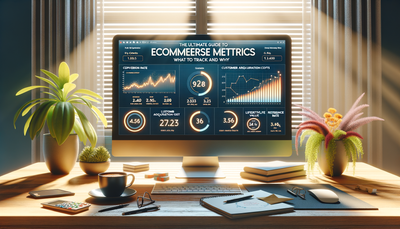Optimizing Your Business Website for Core Web Vitals
Core Web Vitals are a set of user-centric metrics designed to measure the performance and user experience of websites. As search engines increasingly prioritize these metrics in their ranking algorithms, optimizing your business website for Core Web Vitals has become crucial. This article delves into the key metrics that comprise Core Web Vitals, explores tools for measuring and monitoring these metrics, and provides actionable strategies for enhancing your website's performance. By focusing on these vital aspects, you can improve your site's loading speed, responsiveness, and visual stability, ultimately leading to better user engagement, higher conversion rates, and improved search engine rankings.Table of Contents:

Understanding Core Web Vitals
Core Web Vitals consist of three primary metrics that collectively measure a website's loading performance, interactivity, and visual stability. These metrics are:1. Largest Contentful Paint (LCP): Measures loading performance by tracking how long it takes for the largest content element to become visible.
2. First Input Delay (FID): Evaluates interactivity by measuring the time between a user's first interaction and the browser's response.
3. Cumulative Layout Shift (CLS): Assesses visual stability by quantifying unexpected layout shifts during page loading.
By optimizing these metrics, you can significantly enhance your website's overall user experience and potentially improve your search engine rankings.
Do you need a website? Want to build a website but don't know where to start? Our website builder is the perfect solution. Easy to use, and with the ability to customize to fit your business needs, you can have a professional website in no time.
Tools for Measuring Core Web Vitals
To effectively optimize your business website for Core Web Vitals, it's essential to have reliable tools for measurement and monitoring. Some popular options include:1. Google PageSpeed Insights: Provides a comprehensive analysis of your website's performance, including Core Web Vitals scores and suggestions for improvement.
2. Chrome DevTools: Offers in-depth performance audits and real-time monitoring of Core Web Vitals metrics.
3. Google Search Console: Provides a dedicated Core Web Vitals report, highlighting pages that need improvement across your entire site.
4. Lighthouse: An open-source tool that audits web pages for performance, accessibility, and SEO, including Core Web Vitals metrics.
By regularly using these tools, you can track your website's performance and identify areas that require optimization.
Optimizing Largest Contentful Paint (LCP)
To improve your website's LCP score, focus on optimizing the loading time of your largest content elements. Some effective strategies include:1. Optimize images: Compress and resize images, use modern formats like WebP, and implement lazy loading for images below the fold.
2. Minimize server response time: Upgrade your hosting plan, implement caching, and optimize your database queries.
3. Eliminate render-blocking resources: Defer non-critical CSS and JavaScript, and inline critical CSS.
4. Implement content delivery networks (CDNs): Use CDNs to serve static assets from servers closer to your users' geographical locations.
5. Prioritize above-the-fold content: Ensure that the most important content loads first by optimizing the critical rendering path.
Building a website with SITE123 is easy
Enhancing First Input Delay (FID)
To improve your website's FID score and enhance interactivity, consider implementing the following strategies:1. Minimize JavaScript execution time: Split long tasks into smaller ones, use Web Workers for time-consuming operations, and defer non-essential scripts.
2. Optimize third-party scripts: Audit and remove unnecessary third-party scripts, and load them asynchronously when possible.
3. Implement code splitting: Break your JavaScript bundles into smaller chunks and load them on-demand.
4. Use browser caching: Leverage browser caching to store static assets locally on users' devices, reducing load times on subsequent visits.
5. Optimize event handlers: Minimize the use of heavy JavaScript event listeners, especially on frequently triggered events like scrolling or resizing.
Reducing Cumulative Layout Shift (CLS)
To minimize unexpected layout shifts and improve your CLS score, implement these best practices:1. Specify dimensions for images and videos: Always include width and height attributes for media elements to reserve space during loading.
2. Use CSS aspect ratio boxes: Implement aspect ratio boxes for responsive images and videos to maintain proper spacing.
3. Avoid inserting dynamic content: Minimize the use of dynamically injected content above existing content, as it can cause layout shifts.
4. Optimize web fonts: Use the font-display CSS property to control how custom fonts are loaded and displayed.
5. Minimize ad-related layout shifts: Reserve space for ad slots and avoid collapsing empty ad containers.
Implementing Continuous Monitoring and Optimization
Optimizing for Core Web Vitals is an ongoing process that requires continuous monitoring and refinement. To ensure long-term success:1. Set up regular performance audits: Schedule periodic audits using tools like PageSpeed Insights or Lighthouse to track your website's performance over time.
2. Implement real user monitoring (RUM): Use RUM tools to collect data on actual user experiences and identify performance issues in real-world scenarios.
3. Establish performance budgets: Set performance targets for your website and enforce them throughout the development process.
4. Educate your team: Ensure that all team members understand the importance of Core Web Vitals and incorporate best practices into their workflows.
5. Stay updated on best practices: Keep abreast of the latest web performance optimization techniques and adjust your strategies accordingly.





